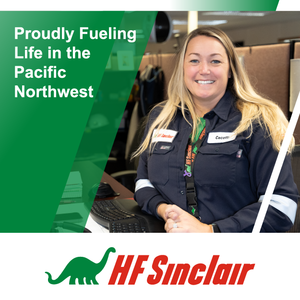Art and science 'Surge' merger closes at MoNA
January 9, 2019

COLLABORATING AGAINST CLIMATE CHANGE – Painter Ann Vandervelde, left, and glass sculptor Lin McJunkin worked with forest ecologist Dave Peterson, interpreting his work with forests and fire. The artists and their science partners want to engage the public for a more involved debate on this intense subject. – Photo courtesy of the artists
Research merged with imagination as scientists and artists gathered for a final time to consider the effects of their expressions about climate change as shown in their MoNA exhibits displayed during the past quarter. A panel of artists and scientists reflected on their collaborative work Saturday, during the last of three discussions about the Surge 2018 exhibit at the Museum of Northwest Art that was open since October.
The goal of this Surge program, hosted by MoNA and the Skagit Climate Science Consortium (SC2), was to understand and express the effects of climate change on the Skagit River watershed and beyond.
Saturday’s panel included scientists John Riedel and Roger Fuller and four artists: Anna McKee, Margot Myers, Mary Coss and Lin McJunkin. All shared stories about their work and what they learned. Artist Rachel Lodge and Riedel moderated the discussion.
The Northwest offers an abundance of both artists and scientists, said Lodge, and Surge’s goal was to leverage both to bring the broad topic of climate change to a local audience. “Climate change on a global scale can seem like an abstraction to people,” Lodge said. “But the impact is local.”
The Skagit Valley serves as a unique subject for climate research, Riedel pointed out. It features the largest watershed that drains into Puget Sound, while the river supports all five salmon species. The valley is vulnerable to flooding, loss of glacier melt and wildfires.
The panel artists each focused on a different aspect of the environment. McKee creates portraits that reveal geologic change, a result of climate change. In that quest she has been to Antarctica and seen how the changes taking place in the far reaches of the planet might affect the watershed in Skagit Valley. For Surge she created pieces that depict the “finger print” of the landscape showing landforms and glacier-decline in West Antarctica and how they result in rising sea levels in the Northwest.
Myers described life growing up in a fishing village in Alaska, among fishermen, where the seasonal work exposed her to outdoor elements that have influenced her work and, she said, “makes me particularly interested in climate change.” She has witnessed the shifts in weather and ecology; and says working with scientists allowed her to connect that personal experience with empirical evidence of the changes and patterns.
She was comfortable, “stomping around in mud and hip boots” with Roger Fuller, where she began a study of soil and the diatoms within that soil that play an important role in the ecosystem. They got to work with an electron microscope and she created an interpretation of what she saw there.
Coss is a sculptor and installation artist whose Surge project focused on salt and its impact on the environment now, and potentially in the future, with climate change. “I love collaboration. I’ve worked with poets, musicians ... so the idea of working with a scientist was really intriguing to me.” It was, she said, an introduction to global warming through a scientist’s eyes. “He took me out to the estuary and we walked. I saw salt as a beautiful material I could work with. I dove into the world of salt.”
As part of her project she asked Fuller to write a journal entry as if writing to a grandchild. “He wrote a beautiful piece,” she said, that she then wrote in bail wire, and dipped in salt.
McJunkin, now in Conway, has had a glass studio in La Conner, and has glass and steel sculptures installed in La Conner as well as Mount Vernon and beyond. She already has a link between science and art. She was a science educator in the Corvallis school system in the 1990s and is a member of the Union of Concerned Scientists.
Climate change has inspired much of her work. She has in fact, created pieces for all three Surge events. This time she worked with scientist David Peterson as well as with painter Ann Vandervelde. They selected trees as the topic they studied and depicted in their project.
“As we moved through the project, wildfires were underway,” she recalled, and she drew from Peterson’s expertise in fire suppression and forest management. Vandervelde painted, and McJunkin subsequently sculpted “The Fire this Time” imagining the forest as parts were consumed by flames.
Fuller appreciates the wetlands as an intersection between the sea, the river and the land. “What I’m interested in is impacts of climate change affecting the food web in small ways and ending up with surprising things happening,” he said.
Fuller’s message to the public: “The planet will continue to exist with or without us. There will be a lot of change happening, and there will be some who are impacted positively. There will be winners and losers.” For humans, he said “there will be a lot of pain but I do have optimism that something will come out the other end.”
Riedel added that climate change offers the chance for people to seek and create solutions. “This is a global problem and also a global opportunity. The solution is going to take everybody’s efforts. This is an opportunity for everyone to look at where they can make a difference.”
Planning for Surge IV is underway.








Reader Comments(0)